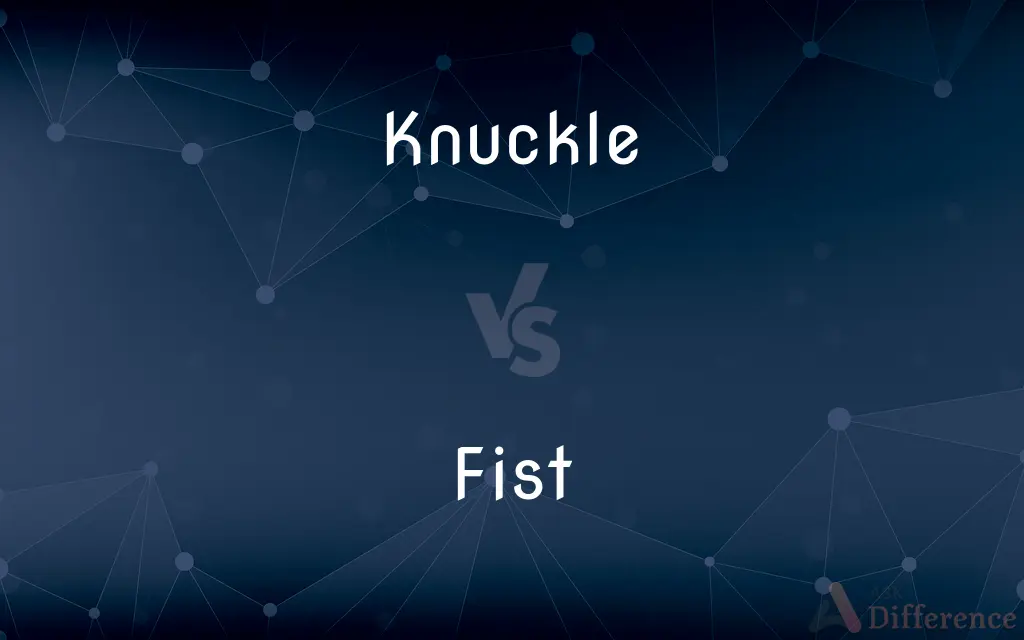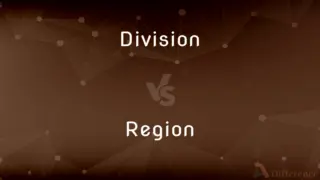Knuckle vs. Fist — What's the Difference?
By Tayyaba Rehman & Maham Liaqat — Updated on April 30, 2024
A knuckle is a part of a finger at a joint where the bone is near the surface, used for precise strikes, whereas a fist involves the whole hand balled up for blunt force.

Difference Between Knuckle and Fist
Table of Contents
ADVERTISEMENT
Key Differences
A knuckle refers to the joint areas of the fingers, where the bone protrudes slightly, making them effective for striking with precision, such as in martial arts. On the other hand, a fist is formed when the fingers and thumb are curled inward toward the palm, creating a compact mass used typically for delivering powerful blows.
Knuckles are individual components of the fingers involved specifically in bending and movement. Whereas the fist represents the collective strength of the hand, serving as a symbol of combat or aggression.
The use of knuckles in striking is often associated with techniques that require precision and aim at specific targets to maximize impact without causing excessive harm to oneself. Conversely, a fist is used for more forceful and less precise impacts, relying on the collective power of the entire hand.
In terms of vulnerability, knuckles, while effective in combat, are more susceptible to injury due to the exposed bones and joints. On the other hand, a fist provides a sturdier and more protected form of striking, with the fingers safeguarded by being tightly folded into the palm.
Knuckles can be used for subtle, focused actions, like knocking on a door or pressing buttons. Meanwhile, the fist can serve various functions beyond fighting, such as hammering or expressing non-verbal communication like solidarity or defiance.
ADVERTISEMENT
Comparison Chart
Definition
Joint of the fingers where the bone protrudes
The hand with fingers curled into the palm
Usage in Combat
Precise strikes
Powerful, blunt strikes
Symbolism
Precision and detail
Strength and aggression
Vulnerability
More prone to injury
Less prone to injury, more protected
Non-combat Usage
Fine motor tasks
Expressive gestures, blunt force
Compare with Definitions
Knuckle
A joint of a finger where the bone is close to the skin.
He rapped his knuckles against the door sharply.
Fist
The hand with fingers and thumb curled inward.
She clenched her fist tightly in anger.
Knuckle
Part of the hand used for precise, pointed impact.
The boxer used his knuckles effectively in the close-range fight.
Fist
A symbol of strength or aggression when balled up.
The crowd raised their fists in solidarity.
Knuckle
A bony protrusion involved in finger flexion.
Her knuckles turned white as she clenched her hand.
Fist
A means of non-verbal communication or expression.
Raising a fist can signify defiance or triumph.
Knuckle
The part of the hand that meets the finger joint.
He cracked his knuckles nervously.
Fist
Used for delivering powerful punches.
The fighter knocked out his opponent with a strong fist.
Knuckle
The point of articulation between finger bones.
Arthritis caused him pain in his knuckles.
Fist
Used for hammering or knocking without a tool.
He pounded the table with his fist to emphasize his point.
Knuckle
The knuckles are the joints of the fingers. The word is cognate to similar words in other Germanic languages, such as the Dutch "knokkel" (knuckle) or German "Knöchel" (ankle), i.e., Knöchlein, the diminutive of the German word for bone (Knochen).
Fist
A hand with the fingers clenched in the palm (as for hitting)
Knuckle
The prominence of the dorsal aspect of a joint of a finger, especially of one of the joints connecting the fingers to the hand.
Fist
A fist is a hand when the fingers are bent in towards the palm and held there tightly. To make or clench a fist is to fold the fingers tightly into the center of the palm and then to clamp the thumb over the middle phalanges; in contrast to this "closed" fist, one keeps the fist "open" by holding the thumb against the side of the index finger.
Knuckle
A rounded protuberance formed by the bones in a joint.
Fist
The hand closed tightly with the fingers bent against the palm.
Knuckle
A cut of meat centering on the carpal or tarsal joint, as of a pig.
Fist
(Informal) A grasp; a clutch
Had a fortune in their fists and let it go.
Knuckle
The part of a hinge through which the pin passes.
Fist
To clench into a fist.
Knuckle
A sharp angle formed by the meeting of two surfaces, especially two ship's timbers.
Fist
To grasp with the fist.
Knuckle
Knuckles Brass knuckles.
Fist
A hand with the fingers clenched or curled inward.
The boxer's fists rained down on his opponent in the last round.
Knuckle
To press, rub, or hit with the knuckles.
Fist
(printing) The pointing hand symbol ☞.
Knuckle
To shoot (a marble) with the thumb over the bent forefinger.
Fist
(ham radio) The characteristic signaling rhythm of an individual telegraph or CW operator when sending Morse code.
Knuckle
Any of the joints between the phalanges of the fingers.
Fist
(slang) A person's characteristic handwriting.
Knuckle
(by extension) A mechanical joint.
Fist
A group of men. en
Knuckle
A cut of meat.
Fist
The talons of a bird of prey.
Knuckle
The curved part of the cushion at the entrance to the pockets on a cue sports table.
Fist
(informal) An attempt at something.
Knuckle
The kneejoint of a quadruped, especially of a calf; formerly used of the kneejoint of a human being.
Fist
The act of breaking wind; fise.
Knuckle
(obsolete) The joint of a plant.
Fist
A puffball.
Knuckle
(shipbuilding) A convex portion of a vessel's figure where a sudden change of shape occurs, as in a canal boat, where a nearly vertical side joins a nearly flat bottom.
Fist
To strike with the fist.
...may not score a point with his open hand(s), but may score a point by fisting the ball. Damian Cullen. "Running the rule." The Irish Times 18 Aug 2003, pg. 52.
Knuckle
A contrivance, usually of brass or iron, and furnished with points, worn to protect the hand, to add force to a blow, and to disfigure the person struck; a knuckle duster.
Brass knuckles
Fist
To close (the hand) into a fist.
Knuckle
The rounded point where a flat changes to a slope on a piste.
Fist
To grip with a fist.
Knuckle
(transitive) To apply pressure, or rub or massage with one's knuckles.
He knuckled the sleep from his eyes.
Fist
(slang) To fist-fuck.
Knuckle
To strike or punch.
Fist
(intransitive) To break wind.
Knuckle
(intransitive) To bend the fingers.
Fist
The hand with the fingers doubled into the palm; the closed hand, especially as clinched tightly for the purpose of striking a blow.
Who grasp the earth and heaven with my fist.
Knuckle
(intransitive) To touch one's forehead as a mark of respect.
Fist
The talons of a bird of prey.
More light than culver in the falcon's fist.
Knuckle
To yield.
Knuckle under
Fist
The index mark [ ], used to direct special attention to the passage which follows.
Knuckle
To land on the knuckle of a curve of a slope, after a jump off a ramp that precedes the slope.
Fist
To strike with the fist.
Knuckle
The joint of a finger, particularly when made prominent by the closing of the fingers.
Fist
To gripe with the fist.
Knuckle
The kneejoint, or middle joint, of either leg of a quadruped, especially of a calf; - formerly used of the kneejoint of a human being.
With weary knuckles on thy brim she kneeled sadly down.
Knuckle
The joint of a plant.
Knuckle
The joining parts of a hinge through which the pin or rivet passes; a knuckle joint.
Knuckle
A convex portion of a vessel's figure where a sudden change of shape occurs, as in a canal boat, where a nearly vertical side joins a nearly flat bottom.
Knuckle
A contrivance, usually of brass or iron, and furnished with points, worn to protect the hand, to add force to a blow, and to disfigure the person struck; - called also knuckle duster, knuckles or brass knuckles.
Knuckle
To yield; to submit; - used with down, to, or under.
Knuckle
To beat with the knuckles; to pummel.
Knuckle
A joint of a finger when the fist is closed
Knuckle
Press or rub with the knuckles
Knuckle
Shoot a marble while keeping one's knuckles on the ground
Common Curiosities
Can you use a knuckle for fighting?
Yes, knuckles can be used for precise strikes in combat situations.
Is making a fist only for fighting?
No, a fist can also express emotions or be used for tasks like knocking.
Which is more vulnerable to injury, knuckles or fists?
Knuckles are more susceptible to injury due to their exposed nature during impacts.
Can the structure of a fist protect the hand?
Yes, the structure of a fist protects the fingers and increases the impact force in punches.
What is a fist?
A fist is made by curling the fingers and thumb into the palm, typically used for delivering powerful blows.
What is a knuckle?
A knuckle is a joint on a finger where the bone is near the surface, used in detailed and precise tasks.
What are the anatomical differences between a knuckle and a fist?
Knuckles are individual finger joints, while a fist is the entire hand configured into a ball for collective strength.
Are there any non-combat uses for knuckles?
Yes, knuckles can be used for tasks requiring fine control, such as pressing small buttons.
What are common uses of fists beyond combat?
Fists can be used for non-verbal communication, hammering, or knocking on surfaces.
How do knuckles and fists differ in their symbolism?
Knuckles symbolize precision, while fists are associated with strength and defiance.
Share Your Discovery

Previous Comparison
Division vs. Region
Next Comparison
Intrabank vs. InterbankAuthor Spotlight
Written by
Tayyaba RehmanTayyaba Rehman is a distinguished writer, currently serving as a primary contributor to askdifference.com. As a researcher in semantics and etymology, Tayyaba's passion for the complexity of languages and their distinctions has found a perfect home on the platform. Tayyaba delves into the intricacies of language, distinguishing between commonly confused words and phrases, thereby providing clarity for readers worldwide.
Co-written by
Maham Liaqat















































